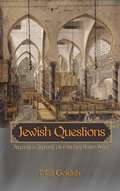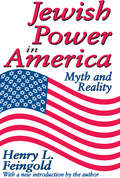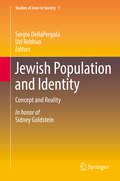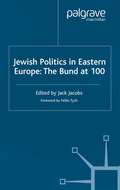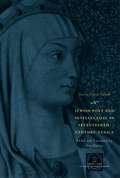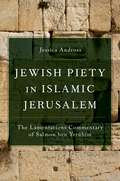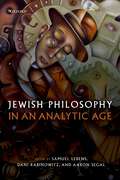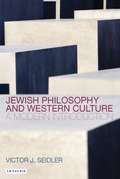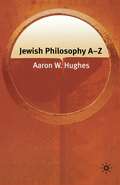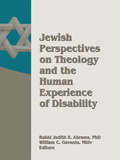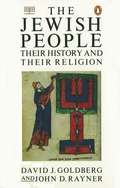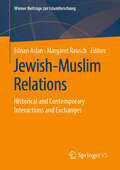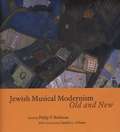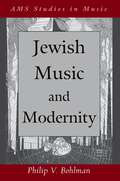- Table View
- List View
Jewish Questions: Responsa on Sephardic Life in the Early Modern Period
by Matt GoldishIn Jewish Questions, Matt Goldish introduces English readers to the history and culture of the Sephardic dispersion through an exploration of forty-three responsa--questions about Jewish law that Jews asked leading rabbis, and the rabbis' responses. The questions along with their rabbinical decisions examine all aspects of Jewish life, including business, family, religious issues, and relations between Jews and non-Jews. Taken together, the responsa constitute an extremely rich source of information about the everyday lives of Sephardic Jews. The book looks at questions asked between 1492--when the Jews were expelled from Spain--and 1750. Originating from all over the Sephardic world, the responsa discuss such diverse topics as the rules of conduct for Ottoman Jewish sea traders, the trials of an ex-husband accused of a robbery, and the rights of a sexually abused wife. Goldish provides a sizeable introduction to the history of the Sephardic diaspora and the nature of responsa literature, as well as a bibliography, historical background for each question, and short biographies of the rabbis involved. Including cases from well-known communities such as Venice, Istanbul, and Saloniki, and lesser-known Jewish enclaves such as Kastoria, Ragusa, and Nablus, Jewish Questions provides a sense of how Sephardic communities were organized, how Jews related to their neighbors, what problems threatened them and their families, and how they understood their relationship to God and the Jewish people.
Jewish Preaching in Times of War, 1800 - 2001 (The Littman Library of Jewish Civilization)
by Marc SapersteinWartime sermons reveal how Jews perceive themselves in relation to the majority society and how Jewish and national values are reconciled when the fate of a nation is at stake. They also illustrate how rabbis guide their communities through the challenges of their times. The sermons reproduced here were delivered by American and British rabbis from across the Jewish spectrum—Orthodox to Liberal, Ashkenazi and Sephardi—from the Napoleonic Wars to the attacks of 9/11. Each sermon is prefaced by a comprehensive introduction explaining the context in which it was delivered. Detailed notes explain allusions unfamiliar to a present-day readership and draw comparisons where appropriate to similar passages in contemporary newspapers and other sermons. A general introduction surveys more broadly the distinctive elements of modern Jewish preaching—the new preaching occasions bound up with the history of the countries in which Jews were living; new modes for the dissemination of the sermons (printed pamphlets and the Jewish and general press), and the emergence of women’s voices from the pulpit. It also surveys the distinctive themes of modern Jewish sermons, including responses to Jewish suffering, social justice, eulogies for national leaders, Zionism, and war. What Jewish religious leaders said to their congregations when their countries went to war (or, in some cases, were considering going to war) raises questions of central significance for both modern Jewish history and religious thinking in the civic context. What evidence do these sermons present concerning the degree of patriotism felt by Jews? Where and when do we find examples of dissent from the policies taken by their governments, or explicit criticism? What theological problems are raised by the preachers in the context of unprecedented and unimagined destruction, and how do they respond to these problems? How is the enemy presented in these texts? How is the problem of Jews fighting and killing other Jews addressed? Are the preachers functioning to articulate traditions that challenge the consensus of the moment, or as instruments of social control serving the needs of governments looking for unquestioning support from their citizenry? In all these areas, this book makes an important contribution to the American- and Anglo-Jewish history of this period while also making available a collection of mostly unknown Jewish texts produced at dramatic moments of the past two centuries.
Jewish Power in America: Myth and Reality
by Henry FeingoldJewish political power exists as a separate agency in the American polity, but before it can be determined whether it is inordinate, historian Henry L. Feingold declares that it first needs to be identified and defined. Jewish power is not associated with military armaments as with a sovereign state like Israel. Nor is it personal power. There are many influential Jews today who have raised huge sums for office seekers, but there are none whose use of financial resources was inordinate. With the exception of an abiding concern with the security of Israel, there are no overriding public policy concerns that differentiate Jewish voters from the informed, educated segment of the American electorate.Feingold acknowledges that American Jews do have political power. But what kind is it, and how does it compare to the power exercised by other ethnic and interest groups that thrive in the American polity? The basic charge of those who have raised the alarm about Jewish power—that it is used conspiratorially against the national interest—is addressed and repudiated. This book addresses the question of Jewish power by examining five recent major instances, beginning with the New Deal, when the play of Jewish power, or power exercised by Jews, was evident.The engagement of American Jewry in the political process is amply documented by survey research and evidenced by the disproportionate number of Jewish office holders on all levels of government. It can be traced in some measure to its relationship to European Jewish migration and to the inherent activism of the political left. The work presents the reader with a broadly comprehensive and highly informative picture of American Jewish participation in the American polity.
Jewish Power in America: Myth and Reality
by Henry FeingoldJewish political power exists as a separate agency in the American polity, but before it can be determined whether it is inordinate, historian Henry L. Feingold declares that it first needs to be identified and defined. Jewish power is not associated with military armaments as with a sovereign state like Israel. Nor is it personal power. There are many influential Jews today who have raised huge sums for office seekers, but there are none whose use of financial resources was inordinate. With the exception of an abiding concern with the security of Israel, there are no overriding public policy concerns that differentiate Jewish voters from the informed, educated segment of the American electorate.Feingold acknowledges that American Jews do have political power. But what kind is it, and how does it compare to the power exercised by other ethnic and interest groups that thrive in the American polity? The basic charge of those who have raised the alarm about Jewish power—that it is used conspiratorially against the national interest—is addressed and repudiated. This book addresses the question of Jewish power by examining five recent major instances, beginning with the New Deal, when the play of Jewish power, or power exercised by Jews, was evident.The engagement of American Jewry in the political process is amply documented by survey research and evidenced by the disproportionate number of Jewish office holders on all levels of government. It can be traced in some measure to its relationship to European Jewish migration and to the inherent activism of the political left. The work presents the reader with a broadly comprehensive and highly informative picture of American Jewish participation in the American polity.
Jewish Population and Identity: Concept and Reality (Studies of Jews in Society #1)
by Sergio DellaPergola Uzi RebhunThis book examines the fundamentals of Jewish demography and sociology around the world. It is not only concerned with documenting patterns of population change but also with an intriguing and ever-present issue like "Who is a Jew?" The latter transcends the limits of quantitative assessment and deeply delves into the nature, boundaries, and quality of group identification. A growing challenge is how to bridge between concept – related to ideals and theory – and reality – reflecting field research. Divided into six sections, the book discusses historical demography, immigration and settlement, population dynamics, social stratification and economy, family and Jewish identity in the U.S., and Jewish identity in Israel. The volume represents the dynamic and diverse nature of the study of world and local Jewish populations. It shows how that field of study provides an important contribution to the broader and now rapidly expanding study of religious and ethnic groups. Scholars in disciplines such as history, geography, sociology, economics, political science, and especially demography follow and analyze the social and cultural patterns of Jews in different places around the globe, at various times, and from complementary perspectives. They make use of historical sources that have recently become accessible, utilize new censuses and surveys, and adopt advanced analytical methods. While some of their observations attest to consistency in the Jews’ demographic and identificational patterns, others evolve and ramify in new directions that reflect general processes in the areas and societies that Jews inhabit, internal changes within Jewish communities, and intergenerational trends in personal preferences of religious and ethnic orientations. This volume brings together contributions from scholars around the world and presents new and updated research and insights.
Jewish Politics in Spinoza's Amsterdam (The Littman Library of Jewish Civilization)
by Anne O. AlbertThis book untangles a web of ideas about politics, religion, exile, and community that emerged at a key moment in Jewish history and left a lasting mark on Jewish ideas. In the shadow of their former member Baruch Spinoza’s notoriety, and amid the aftermath of the Sabbatian messianic movement, the Spanish and Portuguese Jews of seventeenth-century Amsterdam underwent a conceptual shift that led them to treat their self-governed diaspora community as a commonwealth. Preoccupied by the question of why and how Jews should rule themselves in the absence of a biblical or messianic sovereign state or king, they forged a creative synthesis of insights from early modern Christian politics and Jewish law and traditions to assess and argue over their formidable communal government. In so doing they shaped a proud new theopolitical self-understanding of their community as analogous to a Christian state.Through readings of rarely studied sermons, commentaries, polemics, administrative records, and architecture, Anne Albert shows that a concentrated period of public Jewish political discourse among the community’s leaders and thinkers led to the formation of a strong image of itself as a totalizing, state-like entity—an image that eventually came to define its portrayal by twentieth-century historians. Her study presents a new perspective on a Jewish population that has long fascinated readers, as well as new evidence of Jewish reactions to Spinoza and Sabbatianism, and analyses the first Jewish reckoning with modern western political concepts.
Jewish Politics in Eastern Europe: The Bund at 100
by J. JacobsA collection of new, scholarly articles on the Jewish Workers' Bund - the first modern Jewish political party in Eastern Europe - written by prominent academics from eight countries. This work represents a broad range of perspectives, Jewish and non-Jewish, sympathetic to the Bund and critical of its work. The articles in this volume are fresh, make use of previously unused source material, and provide us with new perspectives on the significance of the Bund and its ideas.
Jewish Poet and Intellectual in Seventeenth-Century Venice: The Works of Sarra Copia Sulam in Verse and Prose Along with Writings of Her Contemporaries in Her Praise, Condemnation, or Defense (The Other Voice in Early Modern Europe)
by Sarra Copia SulamThe first Jewish woman to leave her mark as a writer and intellectual, Sarra Copia Sulam (1600?–41) was doubly tainted in the eyes of early modern society by her religion and her gender. This remarkable woman, who until now has been relatively neglected by modern scholarship, was a unique figure in Italian cultural life, opening her home, in the Venetian ghetto, to Jews and Christians alike as a literary salon. For this bilingual edition, Don Harrán has collected all of Sulam’s previously scattered writings—letters, sonnets, a Manifesto—into a single volume. Harrán has also assembled all extant correspondence and poetry that was addressed to Sulam, as well as all known contemporary references to her, making them available to Anglophone readers for the first time. Featuring rich biographical and historical notes that place Sulam in her cultural context, this volume will provide readers with insight into the thought and creativity of a woman who dared to express herself in the male-dominated, overwhelmingly Catholic Venice of her time.
Jewish Poet and Intellectual in Seventeenth-Century Venice: The Works of Sarra Copia Sulam in Verse and Prose Along with Writings of Her Contemporaries in Her Praise, Condemnation, or Defense (The Other Voice in Early Modern Europe)
by Sarra Copia SulamThe first Jewish woman to leave her mark as a writer and intellectual, Sarra Copia Sulam (1600?–41) was doubly tainted in the eyes of early modern society by her religion and her gender. This remarkable woman, who until now has been relatively neglected by modern scholarship, was a unique figure in Italian cultural life, opening her home, in the Venetian ghetto, to Jews and Christians alike as a literary salon. For this bilingual edition, Don Harrán has collected all of Sulam’s previously scattered writings—letters, sonnets, a Manifesto—into a single volume. Harrán has also assembled all extant correspondence and poetry that was addressed to Sulam, as well as all known contemporary references to her, making them available to Anglophone readers for the first time. Featuring rich biographical and historical notes that place Sulam in her cultural context, this volume will provide readers with insight into the thought and creativity of a woman who dared to express herself in the male-dominated, overwhelmingly Catholic Venice of her time.
Jewish Poet and Intellectual in Seventeenth-Century Venice: The Works of Sarra Copia Sulam in Verse and Prose Along with Writings of Her Contemporaries in Her Praise, Condemnation, or Defense (The Other Voice in Early Modern Europe)
by Sarra Copia SulamThe first Jewish woman to leave her mark as a writer and intellectual, Sarra Copia Sulam (1600?–41) was doubly tainted in the eyes of early modern society by her religion and her gender. This remarkable woman, who until now has been relatively neglected by modern scholarship, was a unique figure in Italian cultural life, opening her home, in the Venetian ghetto, to Jews and Christians alike as a literary salon. For this bilingual edition, Don Harrán has collected all of Sulam’s previously scattered writings—letters, sonnets, a Manifesto—into a single volume. Harrán has also assembled all extant correspondence and poetry that was addressed to Sulam, as well as all known contemporary references to her, making them available to Anglophone readers for the first time. Featuring rich biographical and historical notes that place Sulam in her cultural context, this volume will provide readers with insight into the thought and creativity of a woman who dared to express herself in the male-dominated, overwhelmingly Catholic Venice of her time.
Jewish Piety in Islamic Jerusalem: The Lamentations Commentary of Salmon ben Yeruhim (AAR Religion in Translation)
by Jessica AndrussThe emergence of the Jewish Bible commentary in the tenth century marks a turning point in Jewish intellectual history, namely, the transition from ancient rabbinic culture to the Arabized Judaism of the medieval period. This book explores a formative moment in this cultural reorientation by analyzing one of the earliest Jewish Bible commentaries. Written in Arabic in tenth-century Jerusalem, Salmon ben Yeruhim's commentary on Lamentations reveals a nuanced negotiation between the rabbinic tradition and the intellectual resources of the Islamic world. Salmon was a prominent figure among the Karaites, a Jewish movement defined by its commitments to biblical scholarship and penitential practices. For him, Lamentations is "instruction for Israel"--spiritual guidance for the Jewish community in exile--and his task is to communicate that instruction. Jewish Piety in Islamic Jerusalem explores the medieval Arabic dimensions of Salmon's project, tracing his engagement with the nascent fields of Arabic literary theory, historiography, and homiletics. The central argument of the book is that Salmon articulates a Jewish pietistic message through emergent Arabic-Islamic genres, transforming them to reflect his own religious and exegetical commitments. In this way, Salmon applies Arabic learning to the Bible at the same time that his understanding of the biblical text expands the Arabic intellectual tradition. The book advances these claims through six analytical chapters and an annotated English translation of the homilies and excursuses of Salmon's commentary.
Jewish Piety in Islamic Jerusalem: The Lamentations Commentary of Salmon ben Yeruhim (AAR Religion in Translation)
by Jessica AndrussThe emergence of the Jewish Bible commentary in the tenth century marks a turning point in Jewish intellectual history, namely, the transition from ancient rabbinic culture to the Arabized Judaism of the medieval period. This book explores a formative moment in this cultural reorientation by analyzing one of the earliest Jewish Bible commentaries. Written in Arabic in tenth-century Jerusalem, Salmon ben Yeruhim's commentary on Lamentations reveals a nuanced negotiation between the rabbinic tradition and the intellectual resources of the Islamic world. Salmon was a prominent figure among the Karaites, a Jewish movement defined by its commitments to biblical scholarship and penitential practices. For him, Lamentations is "instruction for Israel"--spiritual guidance for the Jewish community in exile--and his task is to communicate that instruction. Jewish Piety in Islamic Jerusalem explores the medieval Arabic dimensions of Salmon's project, tracing his engagement with the nascent fields of Arabic literary theory, historiography, and homiletics. The central argument of the book is that Salmon articulates a Jewish pietistic message through emergent Arabic-Islamic genres, transforming them to reflect his own religious and exegetical commitments. In this way, Salmon applies Arabic learning to the Bible at the same time that his understanding of the biblical text expands the Arabic intellectual tradition. The book advances these claims through six analytical chapters and an annotated English translation of the homilies and excursuses of Salmon's commentary.
Jewish Philosophy in an Analytic Age
by Aaron Segal Samuel Lebens Dani RabinowitzSince the classical period, Jewish scholars have drawn on developments in philosophy to enrich our understanding of Judaism. This methodology reached its pinnacle in the medieval period with figures like Maimonides and continued into the modern period with the likes of Rosenzweig. The explosion of Anglo-American/analytic philosophy in the twentieth century means that there is now a host of material, largely unexplored by Jewish philosophy, with which to explore, analyze, and develop the Jewish tradition. Jewish Philosophy in an Analytic Age features contributions from leading scholars in the field which investigate Jewish texts, traditions, and/or thinkers, in order to showcase what Jewish philosophy can be in an analytic age. United by the new and engaging style of philosophy, the collection explores rabbinic and Talmudic philosophy; Maimonidean philosophy; philosophical theology; and ethics and value theory.
Jewish Philosophy in an Analytic Age
Since the classical period, Jewish scholars have drawn on developments in philosophy to enrich our understanding of Judaism. This methodology reached its pinnacle in the medieval period with figures like Maimonides and continued into the modern period with the likes of Rosenzweig. The explosion of Anglo-American/analytic philosophy in the twentieth century means that there is now a host of material, largely unexplored by Jewish philosophy, with which to explore, analyze, and develop the Jewish tradition. Jewish Philosophy in an Analytic Age features contributions from leading scholars in the field which investigate Jewish texts, traditions, and/or thinkers, in order to showcase what Jewish philosophy can be in an analytic age. United by the new and engaging style of philosophy, the collection explores rabbinic and Talmudic philosophy; Maimonidean philosophy; philosophical theology; and ethics and value theory.
Jewish Philosophy and Western Culture: A Modern Introduction
by Victor J. SeidlerThis is one of the first textbooks to try to set the entire discipline of Jewish philosophy in its proper cultural, historical and spiritual contexts. In so doing, it introduces the vibrant Jewish philosophical tradition to students while also making a significant contribution to inter-religious dialogue. Victor J Seidler argues that the dominant Platonic tradition in the West has led to a form of cultural ethics which asserts false superiority in its relationships with others. He offers a critical reappraisal of the philosophical underpinnings of this western Christian culture which for so long has viewed Judaism with hostility. Examining the work of seminal Jewish thinkers such as Philo, Buber, Mendelsohn, Herman Cohen, Leo Baeck, Levinas, Rosenzweig and others, the author argues for a code of ethics which prioritises particular and personal moral responsibility rather than the impersonal and universal emphases of the Greek tradition. His provocative and original overview of Jewish philosophy uncovers a vital and neglected tradition of thought which transforms our whole philosophical understanding, and which - properly appreciated - works against the likelihood of a Holocaust recurring.
Jewish Philosophy A-Z (Philosophy A-Z)
by NA NAIn an accessible style and format, Jewish Philosophy A-Z covers everything from Philo to Levinas and explores non-Jewish thinkers, such as Plotinus and Heidegger, who have had an important influence on Jewish philosophy.
Jewish Philosophical Polemics Against Christianity in the Middle Ages: With a New Introduction (The Littman Library of Jewish Civilization)
by Daniel J. LaskerThorough and meticulously researched, this study is based on a comprehensive reading of philosophical arguments drawn from all the major Jewish sources, published and unpublished, from the Geonic period in the ninth century until the dawn of the Haskalah in the late eighteenth century. The core of the book is a detailed discussion of the four doctrines of Christianity whose rationality Jews thought they could definitively refute: trinity, incarnation, transubstantiation, and virgin birth. In each case, Daniel Lasker presents a succinct history of the Christian doctrine and then proceeds to a careful examination of the Jewish efforts to demonstrate its impossibility. The main text is clearly written in a non-technical manner, with the Christian doctrines and the Jewish responses both carefully explained; the notes include long quotations, in Hebrew and Arabic as well as in English, from sources that are not readily available in English. At the time of its original publication in 1977 this book was regarded as a major contribution to a relatively neglected area of medieval Jewish intellectual history; the new, wide-ranging introduction prepared for this paperback edition, which surveys and summarizes subsequent scholarship, re-establishes its position as a major work.
Jewish Perspectives on Theology and the Human Experience of Disability
by William GaventaA re-examination of Jewish scripture and teachings about disabilitiesFew people are untouched by the issue of disability, whether personally or through a friend or relative. Jewish Perspectives on Theology and the Human Experience of Disability shares moving insights from around the world and across the broad spectrum of Judaism on how and why the Jewish community is incomplete without the presence and participation of the disabled. Authors representing each of the three main movements of Judaism-Orthodox, Conservative, and Reform-examine theology, scripture, ethics, practical theology, religious education, and personal experience to understand and apply the lessons and wisdom of the past to issues of the present.Authors from Israel, the United States, the United Kingdom, and Australia reflect on their theological understandings of specific disabilities and on disability as a whole. Jewish Perspectives on Theology and the Human Experience of Disability re-examines tradition, teachings, and beliefs to shatter stereotypes of Judaism and common interpretations of scripture. This unique book addresses several disabilities (blindness, deafness, intellectual disabilities, autism, learning disabilities), and a wide range of topics, including human rights and disabilities, Jewish laws concerning niddah, misconceptions about disabilities in the Hebrew Bible, Jewish community programs to include people with disabilities, and the need to educate American Jews about Jewish genetic diseases.Jewish Perspectives on Theology and the Human Experience of Disability examines: three methods that allow Jews who are blind to participate in the Torah service the spiritual needs of people with learning disabilities the attitude of Jewish Law toward marriage and parenthood on people with intellectual disabilities how the rabbis of the Mishnah incorporated Greco-Roman beliefs about the connections between hearing, speech, and intelligence into Jewish law a sampling of opinions issued on matters concerning disabilities by the Responsa Committee of the Central Conference of American Rabbis how the Jewish sages have made participation by people with disabilities possible and much moreJewish Perspectives on Theology and the Human Experience of Disability also includes reviews of Judaism and Disability: Portrayals in Ancient Texts from the Tanach through the Bavil and Disability in Jewish Law, as well as comprehensive resource collections. This book is an essential read for clergy and lay leaders involved in the support of people with disabilities, for the families of people with disabilities, and for anyone working with the disabled.
Jewish Perspectives on Theology and the Human Experience of Disability
by William GaventaA re-examination of Jewish scripture and teachings about disabilitiesFew people are untouched by the issue of disability, whether personally or through a friend or relative. Jewish Perspectives on Theology and the Human Experience of Disability shares moving insights from around the world and across the broad spectrum of Judaism on how and why the Jewish community is incomplete without the presence and participation of the disabled. Authors representing each of the three main movements of Judaism-Orthodox, Conservative, and Reform-examine theology, scripture, ethics, practical theology, religious education, and personal experience to understand and apply the lessons and wisdom of the past to issues of the present.Authors from Israel, the United States, the United Kingdom, and Australia reflect on their theological understandings of specific disabilities and on disability as a whole. Jewish Perspectives on Theology and the Human Experience of Disability re-examines tradition, teachings, and beliefs to shatter stereotypes of Judaism and common interpretations of scripture. This unique book addresses several disabilities (blindness, deafness, intellectual disabilities, autism, learning disabilities), and a wide range of topics, including human rights and disabilities, Jewish laws concerning niddah, misconceptions about disabilities in the Hebrew Bible, Jewish community programs to include people with disabilities, and the need to educate American Jews about Jewish genetic diseases.Jewish Perspectives on Theology and the Human Experience of Disability examines: three methods that allow Jews who are blind to participate in the Torah service the spiritual needs of people with learning disabilities the attitude of Jewish Law toward marriage and parenthood on people with intellectual disabilities how the rabbis of the Mishnah incorporated Greco-Roman beliefs about the connections between hearing, speech, and intelligence into Jewish law a sampling of opinions issued on matters concerning disabilities by the Responsa Committee of the Central Conference of American Rabbis how the Jewish sages have made participation by people with disabilities possible and much moreJewish Perspectives on Theology and the Human Experience of Disability also includes reviews of Judaism and Disability: Portrayals in Ancient Texts from the Tanach through the Bavil and Disability in Jewish Law, as well as comprehensive resource collections. This book is an essential read for clergy and lay leaders involved in the support of people with disabilities, for the families of people with disabilities, and for anyone working with the disabled.
The Jewish People: Their History and Their Religion (Penguin Religion And Mythology Ser.)
by David Goldberg John RaynerThe first part of this illustrated volume offers a survey of Jewish history and literature. The second part presents what the preface describes as "a thematic analysis of the teachings and practice of Judaism".
Jewish Mysticism: The Infinite Expression of Freedom (The Littman Library of Jewish Civilization)
by Rachel EliorMysticism, which transcends the boundaries of time and space and refers to a reality not grasped by means of ordinary human cognition, is one of the central sources of inspiration of religious thought. It is an attempt to decode the mystery of divine existence by penetrating to the depths of consciousness through language, memory, myth, and symbolism. Delving deep into the psyche, mystics strive to redeem perceived reality from its immediate meaning. Mystical texts constitute a history of this religious creativity, of man’s attempt to reveal the divine structure underlying the chaos of reality and thereby endow life with hope and purpose. By offering an alternative perspective on the world that gives expression to yearnings for freedom and change, mysticism engenders new modes of authority and leadership; as such it plays a decisive role in moulding religious and social history. For all these reasons, the mystical corpus deserves study and discussion in the framework of cultural criticism and research. This study is a lyrical exposition of the Jewish mystical phenomenon. It is based on a close reading of the hundreds of volumes written by Jewish mystics and incorporates mystical testimonies drawn from the different countries and cultural environments in which Jews have lived. Rachel Elior’s purpose is to present, as accurately as possible, the meanings of the mystical works as they were perceived by their creators and readers. At the same time, she contextualizes them within the boundaries of the religion, culture, language, and spiritual and historical circumstances in which the destiny of the Jewish people has evolved. The author succeeds in drawing the reader into a mystical world. With great intensity, she conveys the richness of the mystical experience in discovering the infinity of meaning embedded in the sacred text; teasing out the recurring themes, she explains the multivalent symbols. Using copious extracts from Jewish mystical sources, she illustrates the varieties of the mystical experience from antiquity to the twentieth century. She succeeds in eloquently conveying how mystics try to decipher reality by penetrating beyond its apparent boundaries: how they experience spiritual powers symbolically, imaginatively, or visually; how hidden truths are revealed in visions or dreams, in an epiphany or as ‘lightning’; how they are ‘engraved’ in the mind or illuminate in the soul. Most of the texts she draws on are written in very obscure language, but the skilful translations communicate the mystical experiences vividly and make it easy for the reader to understand how Elior uses them to explain the relationship between the revealed world and the hidden world and between the mystical world and the traditional religious world, with all the social and religious tensions this has caused.
Jewish-Muslim Relations: Historical and Contemporary Interactions and Exchanges (Wiener Beiträge zur Islamforschung)
by Ednan Aslan Margaret RauschThis multidisciplinary volume unites research on diverse aspects of Jewish-Muslim relations, exchanges and coexistence across time including the Abrahamic tradition enigma, Jews in the Qur’an and Hadith, Ibn al-‘Arabi and the Kabala, comparative feminist theology, Jews, Christians, Muslims and the Gospel of Barnabas, harmonizing religion and philosophy in Andalusia, Jews and Muslims in medieval Christian Spain, Israeli Jews and Muslim and Christian Arabs, Jewish-Muslim coexistence on Cyprus, Muslim-Jewish dialogues in Berlin and Barcelona, Jewish-Christian-Muslim trialogues and teleology, Jewish and Muslim dietary laws, and Jewish and Muslim integration in Switzerland and Germany.
Jewish Musical Modernism, Old and New
by Philip V. Bohlman Sander L. GilmanTackling the myriad issues raised by Sander Gilman’s provocative opening salvo—”Are Jews Musical?”—this volume’s distinguished contributors present a series of essays that trace the intersections of Jewish history and music from the late nineteenth century to the present. Covering the sacred and the secular, the European and the non-European, and all the arenas where these realms converge, these essays recast the established history of Jewish culture and its influences on modernity. Mitchell Ash explores the relationship of Jewish scientists to modernist artists and musicians, while Edwin Seroussi looks at the creation of Jewish sacred music in nineteenth-century Vienna. Discussing Jewish musicologists in Austria and Germany, Pamela Potter details their contributions to the “science of music” as a modern phenomenon. Kay Kaufman Shelemay investigates European influence in the music of an Ethiopian Jewish community, and Michael P. Steinberg traces the life and works of Charlotte Salomon, whose paintings staged the destruction of the Holocaust. Bolstered by Philip V. Bohlman’s wide-ranging introduction and epilogue, and featuring lush color illustrations and a complementary CD of the period’s music, this volume is a lavish tribute to Jewish contributions to modernity.
Jewish Musical Modernism, Old and New
by Philip Vilas Bohlman Sander L. GilmanTackling the myriad issues raised by Sander Gilman’s provocative opening salvo—”Are Jews Musical?”—this volume’s distinguished contributors present a series of essays that trace the intersections of Jewish history and music from the late nineteenth century to the present. Covering the sacred and the secular, the European and the non-European, and all the arenas where these realms converge, these essays recast the established history of Jewish culture and its influences on modernity. Mitchell Ash explores the relationship of Jewish scientists to modernist artists and musicians, while Edwin Seroussi looks at the creation of Jewish sacred music in nineteenth-century Vienna. Discussing Jewish musicologists in Austria and Germany, Pamela Potter details their contributions to the “science of music” as a modern phenomenon. Kay Kaufman Shelemay investigates European influence in the music of an Ethiopian Jewish community, and Michael P. Steinberg traces the life and works of Charlotte Salomon, whose paintings staged the destruction of the Holocaust. Bolstered by Philip V. Bohlman’s wide-ranging introduction and epilogue, and featuring lush color illustrations and a complementary CD of the period’s music, this volume is a lavish tribute to Jewish contributions to modernity.
Jewish Music and Modernity (AMS Studies in Music)
by Philip BohlmanJewish Music and Modernity demonstrates how borders between repertories are crossed and the sound of modernity is enriched by the movement of music and musicians from the peripheries to the center of modern culture. Bohlman ultimately challenges readers to experience the modern confrontation of self and other anew.
